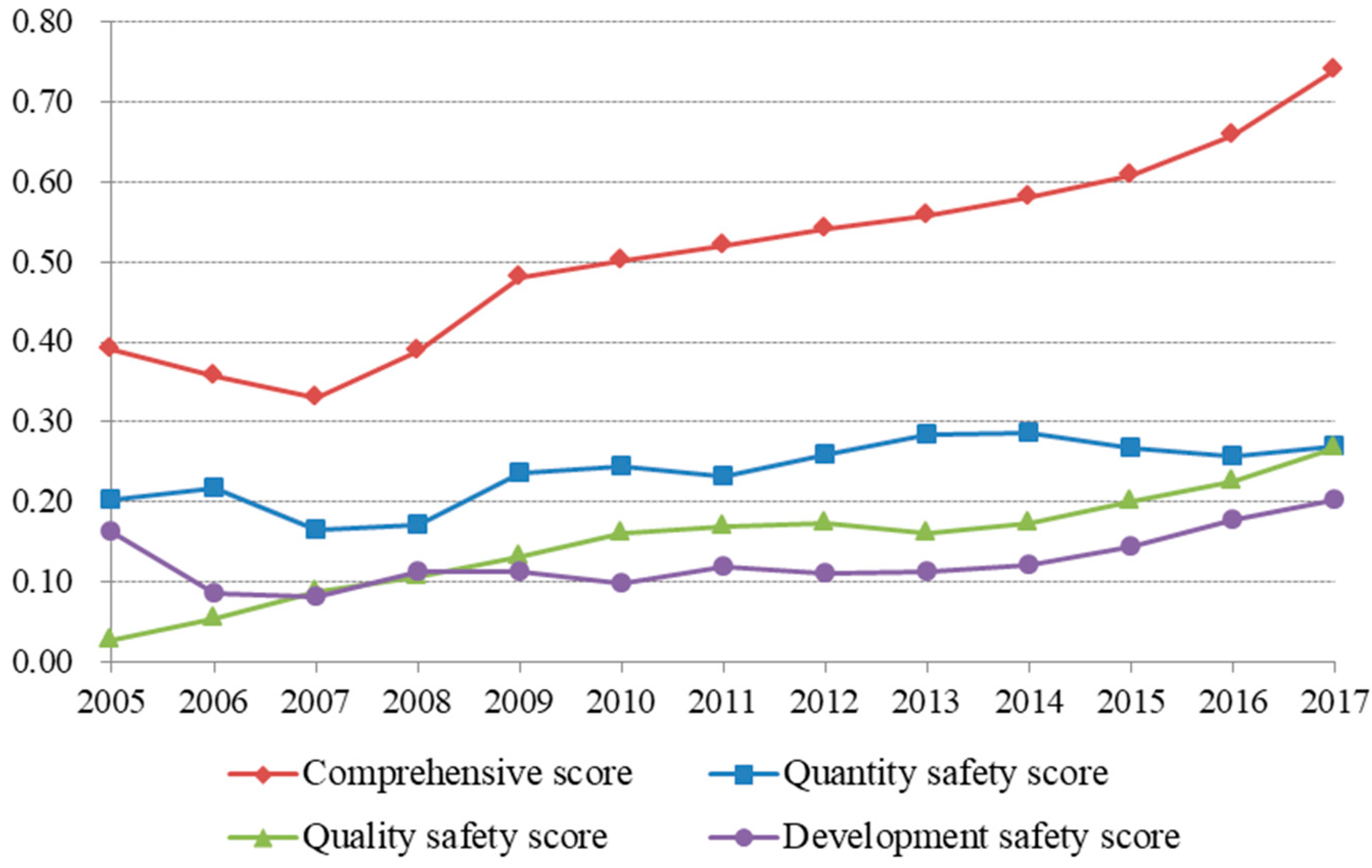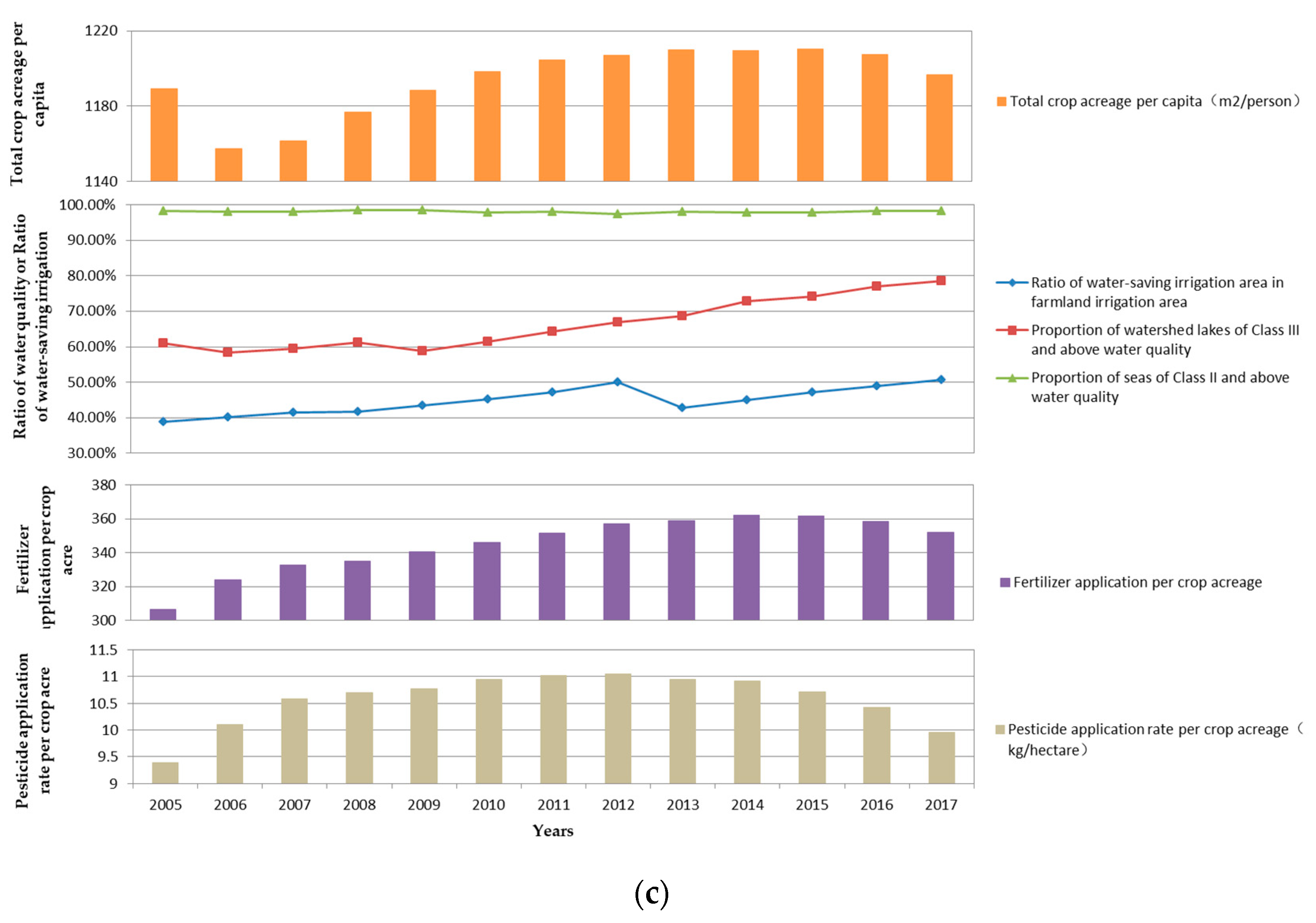Study on Evolution of Food Safety Status and Supervision Policy—A System Based on Quantity, Quality, and Development Safety
Abstract
1. Introduction
2. Development History of Food Safety Supervision in China
2.1. Absolutely Centralized Supervision (1949–1964)
2.2. Mixed Supervision (1965–1992)
2.3. Primary Stage of Stage-Based Supervision (1993–2002)
2.4. Development Stage of Stage-Based Supervision (2003–Present)
3. Construction, Data Sources, and Research Methods of the Index System
3.1. Construction of the Index System
3.2. Data Sources
3.3. Research Methods
4. Empirical Analysis Based on the Entropy Method
5. Conclusions
6. Inspiration for Policies
Author Contributions
Funding
Acknowledgments
Conflicts of Interest
References
- Ortega, D.L.; Wang, H.H.; Wu, L.; Olynk, N.J. Modeling heterogeneity in consumer preferences for select food safety attributes in China. Food Policy 2011, 36, 318–324. [Google Scholar] [CrossRef]
- Caswell, J.A.; Padberg, D.I. Toward a more comprehensive theory of food label. Am. J. Agric. Econ. 1992, 74, 460–468. [Google Scholar] [CrossRef]
- Li, G.K.; Ying, R.Y. “Lemon market” and institutional arrangement—An analytical framework on the quality and safety guarantee of agricultural products. J. Agrotech. Econ. 2004, 2, 16–21. [Google Scholar]
- Caswell, J.A.; Mojduszka, E.M. Using informational labeling to influence the market for quality in food products. Am. J. Agric. Econ. 1996, 78, 1248–1253. [Google Scholar] [CrossRef]
- Antle, J.M. Efficient food safety regulation in the food manufacturing sector. Am. J. Agric. Econ. 1996, 78, 1242–1247. [Google Scholar] [CrossRef]
- Barling, D.; Lang, T. The politics of food. Polit Quart. 2003, 1, 4–7. [Google Scholar] [CrossRef]
- Tompkin, R.B. Interactions between government and industry food safety activities. Food Control 2001, 12, 203–207. [Google Scholar] [CrossRef]
- Variyam, J.N.; Blaylock, J.; Smallwood, D.M. Modeling nutrition knowledge, attitudes, and diet-disease awareness the case of dietary fibre. Stat. Med. 1996, 15, 23–25. [Google Scholar] [CrossRef]
- Perry, W.R.; Marsh, T.; Jones, R.; Sanderson, M.W.; Sargeant, J.M.; Griffin, D.D.; Smith, R.A. Joint product management strategies for E. coli O157 and feedlot profits. Food Policy 2007, 32, 544–565. [Google Scholar] [CrossRef]
- Peacock, W.J. The role of gene technology in food agribusiness systems. Food Aust. 2000, 52, 367–370. [Google Scholar]
- Kako, T. Food self-sufficiency and food security. J. Rural Probl. 2000, 35, 171–176. [Google Scholar] [CrossRef]
- Roasto, M.; Hérman, A.; Hanninen, M.L. A food safety perspective. In Ecology and Animal Health; Baltic University Press: Uppsala, Sweden, 2012. [Google Scholar]
- Dijk, H.V.; Houghton, J.; Kleef, E.V.; Lans, I.V.D.; Rowe, G.; Frewer, L. Consumer responses to communication about food risk management. Appetite 2008, 50, 340–352. [Google Scholar] [CrossRef] [PubMed]
- Caswell, J.A.; Hooker, N.H. HACCP as an international trade standard. Am. J. Agric. Econ. 1996, 78, 775–779. [Google Scholar] [CrossRef]
- Regattieri, A.; Gamberi, M.; Manzini, R. Traceability of food products: General framework and experimental evidence. J. Food Eng. 2007, 81, 347–356. [Google Scholar] [CrossRef]
- Kim, R. Japanese consumers’ use of extrinsic and intrinsic cues to mitigate risky food choices. Int. J. Consum. Stud. 2010, 32, 49–58. [Google Scholar] [CrossRef]
- Jouanjean, M.A.; Maur, J.C.; Shepherd, B. Reputation matters: Spillover effects for developing countries in the enforcement of US food safety measures. Food Policy 2015, 55, 81–91. [Google Scholar] [CrossRef]
- Sohn, M.C.; Oh, S. Global harmonization of food safety regulation from the perspective of Korea and a novel fast automatic product recall system. J. Sci. Food Agric. 2014, 94, 1932–1937. [Google Scholar] [CrossRef]
- Carlo, R.; Maria, P.A.; Di, F.A. Using private food safety standards to manage complexity: A moral hazard perspective. Agric. Econ. Rev. 2014, 15, 113–127. [Google Scholar]
- Antle, J.M. No such thing as a free safe lunch: The cost of food safety regulation in the meat industry. Am. J. Agric. Econ. 2000, 82, 310–322. [Google Scholar] [CrossRef]
- Liu, P. Chinese food safety regulation an empirical study on regime change and performance evaluation. J. Public Manag. 2010, 7, 63–78. [Google Scholar]
- Li, Z.D.; Zhang, Z.S. Analysis of Food Safety Regulation Effect and Its Influencing Factors. Available online: http://www.cnki.com.cn/Article/CJFDTotal-ZNJJ201506011.htm (accessed on 16 November 2019).
- Lu, L.S. Strategic Adjustment of Agricultural Structure and Food Safety in China in The New Era. Available online: http://www.cnki.com.cn/Article/CJFDTotal-ZGWY200204000.htm (accessed on 16 November 2019).
- Smith, L.C.; Obeid, A.E.E.; Jensen, H.H. The geography and causes of food insecurity in developing countries. Agric. Econ. Blackwell 2015, 22, 199–215. [Google Scholar] [CrossRef]
- Dai, F.; Ji, G.P. A new kind of pricing model for commodity and estimating indexes system for price security. Chin. J. Manag. Sci. 2001, 9, 62–69. [Google Scholar]
- Mohand, N.N.; Hammoudi, A.; Radjef, M.S.; Hamza, O.; Perito, M.A. How do food safety regulations influence market price? A theoretical analysis. Br. Food J. 2017, 119, 1687–1704. [Google Scholar] [CrossRef]
- Jacxsens, L.; Uyttendaele, M.; Dexlieghere, F.; Rovira, J.; Oses, S.; Luning, P.A. Food Safety Performance Indicators to Benchmark Food Safety Output of Food Safety Management System. Int. J. Food. Microbiol. 2010, 141, 181–184. [Google Scholar] [CrossRef]
- Atafar, Z.; Mesdaghinia, A.; Nouri, J.; Homaee, M.; Yunesian, M.; Ahmadimoghaddam, M.; Mahvi, A.H. Effect of fertilizer application on soil heavy metal concentration. Environ. Monit. Assess. 2010, 160, 83–89. [Google Scholar] [CrossRef]
- Casweu, J.A. How labeling of safety and process attributes affects markets for food. Agric. Resour. Econ. Rev. 1998, 27, 151–158. [Google Scholar] [CrossRef]
- Yang, J.H.; Lin, Y.B. Spatiotemporal evolution and driving factors of fertilizer reduction control in Zhejiang Province. Sci. Total Environ. 2019, 660, 650–659. [Google Scholar] [CrossRef]
- Okey, B.W. Systems approaches and properties, and agroecosystem health. J. Environ. Manag. 1996, 48, 187–199. [Google Scholar] [CrossRef]
- Dyson, J.S. Ecological safety of paraquat with particular reference to soil. Planter 1997, 73, 467–478. [Google Scholar]
- Pan, Z.W.; Jin, J.L.; Liu, X.W.; Zhou, R.X. Mechanism and Evaluation Method of Water Resources Utilization System Vulnerability. J. Nat. Resour. 2016, 31, 1599–1609. [Google Scholar]
- Rao, J. Research on the plight of water-saving agriculture construction in china by project system. Issues Agric. Econ. 2017, 1, 83–90. [Google Scholar]
- Boer, P.T.D.; Kroese, D.P.; Rubinstein, R.Y. A Fast cross-entropy method for estimating buffer overflows in queueing networks. Manag. Sci. 2004, 50, 883–895. [Google Scholar] [CrossRef][Green Version]



| Sub−System | Index | Unit | Direction |
|---|---|---|---|
| Quantity safety (A) | Per capita consumption of grain (A1) | kg/person | (−) |
| Per capita consumption of meat and poultry products (A2) | kg/person | (−) | |
| Per capita consumption of aquatic products (A3) | kg/person | (−) | |
| Per capita consumption of edible vegetable oil (A4) | kg/person | (−) | |
| Per capita yield of grain (A5) | kg/person | (+) | |
| Per capita yield of meat (A6) | kg/person | (+) | |
| Per capita yield of aquatic products (A7) | kg/person | (+) | |
| Per capita yield of edible vegetable oil (A8) | kg/person | (+) | |
| Retail price index (RPI) of food (A9) | % | (−) | |
| RPI of drinks, tobacco, and alcohol (A10) | % | (−) | |
| Quality safety (Q) | Food pass rate in spot checks (Q1) | % | (+) |
| Pass rate of pesticide residue in vegetables (Q2) | % | (+) | |
| Pass rate of pesticide residue in aquatic products (Q3) | % | (+) | |
| Ratio of quality and safety complaints in agricultural means of production (Q4) | % | (−) | |
| Ratio of quality and safety complaints in food commodities (Q5) | % | (−) | |
| Ratio of quality and safety complaints in catering service (Q6) | % | (−) | |
| Development safety (D) | Total crop acreage per capita (D1) | m2/person | (+) |
| Proportion of watershed lakes of Class III and above water quality (D2) | % | (+) | |
| Proportion of seas of Class II and above water quality (D3) | % | (+) | |
| Fertilizer application per crop acre (D4) | kg/hectare | (−) | |
| Pesticide application rate per crop acre (D5) | kg/hectare | (−) | |
| Ratio of water−saving irrigation area to farmland irrigation area (D6) | % | (+) |
| Sub-System | Index | Weight (%) |
|---|---|---|
| Quantity safety (A) | Per capita consumption of grain (A1) | 4.6160% |
| Per capita consumption of meat and poultry products (A2) | 4.3602% | |
| Per capita consumption of aquatic products (A3) | 4.5304% | |
| Per capita consumption of edible vegetable oil (A4) | 4.3383% | |
| Per capita yield of grain (A5) | 4.5722% | |
| Per capita yield of meat (A6) | 4.5717% | |
| Per capita yield of aquatic products (A7) | 4.6015% | |
| Per capita yield of edible vegetable oil (A8) | 4.6031% | |
| RPI of food (A9) | 4.4760% | |
| RPI of drinks, tobacco, and alcohol (A10) | 4.5213% | |
| Quality safety (Q) | Food pass rate in spot check (Q1) | 4.4033% |
| Pass rate of pesticide residue in vegetables (Q2) | 4.3839% | |
| Pass rate of pesticide residue in aquatic products (Q3) | 4.3509% | |
| Ratio of quality and safety complaints in agricultural means of production (Q4) | 4.6919% | |
| Ratio of quality and safety complaints in food commodities (Q5) | 4.7400% | |
| Ratio of quality and safety complaints in catering service (Q6) | 4.7018% | |
| Development safety (D) | Total crop acreage per capita (D1) | 4.4260% |
| Proportion of watershed lakes of Class III and above water quality (D2) | 4.7102% | |
| Proportion of seas of Class II and above water quality (D3) | 4.4475% | |
| Fertilizer application per crop acre (D4) | 4.6423% | |
| Pesticide application rate per crop acre (D5) | 4.7071% | |
| Ratio of water-saving irrigation area in farmland irrigation area (D6) | 4.6047% |
© 2019 by the authors. Licensee MDPI, Basel, Switzerland. This article is an open access article distributed under the terms and conditions of the Creative Commons Attribution (CC BY) license (http://creativecommons.org/licenses/by/4.0/).
Share and Cite
Yang, J.; Lin, Y. Study on Evolution of Food Safety Status and Supervision Policy—A System Based on Quantity, Quality, and Development Safety. Sustainability 2019, 11, 6656. https://doi.org/10.3390/su11236656
Yang J, Lin Y. Study on Evolution of Food Safety Status and Supervision Policy—A System Based on Quantity, Quality, and Development Safety. Sustainability. 2019; 11(23):6656. https://doi.org/10.3390/su11236656
Chicago/Turabian StyleYang, Jianhui, and Yaoben Lin. 2019. "Study on Evolution of Food Safety Status and Supervision Policy—A System Based on Quantity, Quality, and Development Safety" Sustainability 11, no. 23: 6656. https://doi.org/10.3390/su11236656
APA StyleYang, J., & Lin, Y. (2019). Study on Evolution of Food Safety Status and Supervision Policy—A System Based on Quantity, Quality, and Development Safety. Sustainability, 11(23), 6656. https://doi.org/10.3390/su11236656





